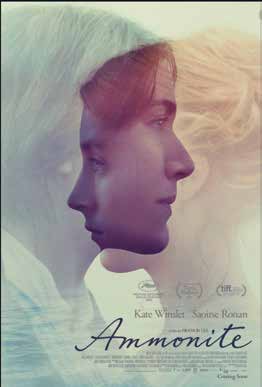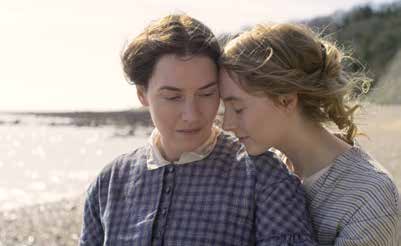
By Gary Kramer–
Ammonite is the sophomore feature by out gay writer/director Francis Lee (God’s Own Country). This romantic drama is set in the 1840s in the British coastal town of Lyme Regis, where Mary Anning (Kate Winslet) collects and sells fossils. She prefers them to people, it seems.
When the wealthy Roderick Murchison (James McArdle) and his melancholic wife Charlotte (Saoirse Ronan) arrive in town, he pays Mary to study alongside her. He also asks Mary to care for Charlotte when he travels. She reluctantly agrees.

Charlotte soon falls quite ill, prompting Mary to nurse her back to health. As the women spend more time together, even sharing a bed, they develop feelings for one another—an impulsive kiss leads to some rather explicit passions, and the vigorous sex scenes enliven this romantic drama. The film features lovely costumes, and there is a nice thorny exchange between Mary and her ex, Elizabeth (out actress Fiona Shaw), who cottons to Charlotte one evening. But the strength of Ammonite, a romance novel in Masterpiece Theater guise, is Winslet’s gritty performance as the proud, stubborn Mary, and Ronan’s delicate turn as the sexually awakened Charlotte.
In a recent interview, Lee spoke with me for the San Francisco Bay Times about his handsomely mounted period romance, which opens November 13.
Gary Kramer: How did you learn about Mary Anning and decide to make a film about her?
Francis Lee: I knew I never wanted to do a biography of her—that’s limiting. The nuts and bolts of her story are real. She lived in Lyme Regis and fossiled on the beaches. Charlotte is real, though she was slightly older [than Saoirse]. But Roderick did leave Charlotte in Lyme Regis. Elizabeth is real. There’s virtually nothing written about Mary by her contemporaries. I put that down to her being a working-class woman in a patriarchal, class-ridden society. There was no evidence whatsoever that she had relationships with men, but she had friendships with women like Elizabeth and Charlotte. I wanted to give her a relationship that was worthy of her and lifted her up. I did not feel that could be with a man, so I wanted her to have a relationship that would be more equal. I did research on women same-sex relationships in the 1800s.
Gary Kramer: Ammonite addresses issues of class and gender. Can you talk about how women had to operate in this very rigid society and how your film portrays feminist agency?
Francis Lee: Mary wasn’t a suffragette; she didn’t work outside the society or try to change society in a political way. She operated within it and within the patriarchy, but was very self-possessed within that. In a sense, she was accepting some of society’s rules but still operating how you want to live and be. What I found fascinating about class for Mary, who came from a working-class background, was her aim for finding fossils was to earn money and put food on the table whereas Elizabeth was doing it as a hobby. Mary’s interest in science was her passion.

Gary Kramer: What can you say about the symbolism in the film? When fossiling, Charlotte’s husband Roderick finds zilch. Charlotte is unable to peel a carrot and stumbles in coal. Mary’s mother Molly (Gemma Jones) collects figurines. Elizabeth has an incredible garden. This film has an almost literary quality to it. Can you talk about that aspect?
Francis Lee: The reason I like cinema and storytelling is because it’s a visual medium. I’m drawn to telling stories with pictures, not necessarily words. When I write the script, I think people are surprised that I strip out dialogue to say things with pictures, so imagery in the film is telling you things about the characters, their world, and it moves the story along.
Gary Kramer: The lead actresses are both outstanding and Fiona Shaw and Alec Secareanu lend fine support. What guidance did you give the cast, or what about the performers made them right for the roles in your mind?
Francis Lee: I love transformative actors and ones who play very different from themselves emotionally and physically. All the core players I knew sensed the ability and relish to do that. I work with actors early on—five months before shooting—and we start developing characters and we investigate every detail. This is only my second film. Kate and Saoirse are more experienced than I am, but it was wonderful they worked in the way I wanted to work. They were open and free to strip themselves of what they had done before and start afresh with a process and a character. We worked very collaboratively, building these characters. They took me on board shaping them, polishing bits and bringing bits down. It’s hard for an actor, who is so established, to be asked to do something different than what they are used to doing. It was wonderful to orchestrate the performances in that way.
© 2020 Gary M. Kramer
Gary M. Kramer is the author of “Independent Queer Cinema: Reviews and Interviews,” and the co-editor of “Directory of World Cinema: Argentina.” Follow him on Twitter @garymkramer
Published on November 5, 2020
Recent Comments